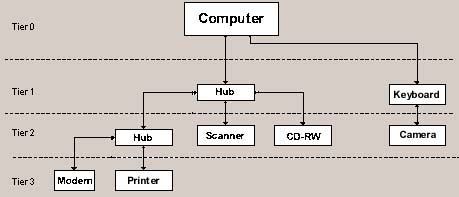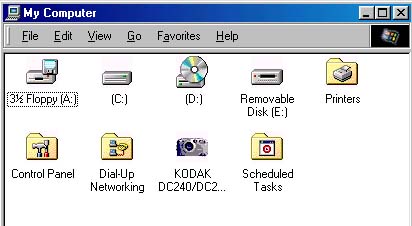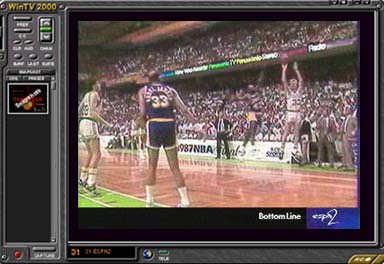Universal Serial Bus
We know that all of the loyal Computer Tips readers are ever grateful for
this series of tips, and you have probably all been wondering what you can
do to thank us for all this information.
Your first tip today is...
|
When buying someone a gift, buy them something that they already have a lot
of, because that is obviously something that they like.
|
So if you were looking to buy us a gift, you would buy us computer hardware!
Yes, there is no gadget that we would not love to have.
You buy it, we'll try it out.
Now, having said that, you would think that there would be some limit to how many
"things" (which we computer people might call peripheral devices) we
could actually connect to our computer.
Historically, allocating the precious resources of your system unit to multiple
peripheral devices has been a major problem.
Probably the most onerous culprit in this endeavor has been trying to assign
a unique IRQ (interrupt request line) to each device.
The general rule has always been that each device had to have its own separate IRQ,
Good news is here!
No longer do we have to crawl around on the floor plugging and unplugging devices.
No longer do we have to remove the cover of our computers to install and remove devices
(although, admittedly, this is fun to do).
No longer do we have to fight the IRQ battle.
Universal Serial Bus (USB) is a relatively new external input/output interface that
greatly enhances the portability of peripheral devices.
USB devices are external to your actual system unit, so they are much more
accessible than internal devices -- you need not remove the cover of your computer
to install or remove a USB device.
USB devices are Plug and Play, so setup and configuration is relatively easy.
USB devices are even hot swappable, meaning that you shouldn't have to
reboot your computer just because you have plugged in a new USB device.
 USB supports up to 127 devices (yes, up to 127 devices!), arranged in a tiered star topology
(see the diagram to the right).
Most new computers today come supplied with two USB ports.
Additionally, many USB devices are equipped with one or more USB ports into which you can
plug yet another USB device, daisy-chaining your USB devices one after another.
In the diagram to the right, a USB-enabled keyboard (on the far right of the diagram) plugs into the host computer;
the keyboard is equipped with a USB port, into which a digital camera can be plugged.
Plugging your camera into your keyboard is certainly much more convenient than getting
down onto the floor and crawling under your desk to find a port on the back of your computer!
Thus, one of the nice features of USB is the ease with which you can connect devices physically.
That is, your ports can be made to be easily accessible.
USB supports up to 127 devices (yes, up to 127 devices!), arranged in a tiered star topology
(see the diagram to the right).
Most new computers today come supplied with two USB ports.
Additionally, many USB devices are equipped with one or more USB ports into which you can
plug yet another USB device, daisy-chaining your USB devices one after another.
In the diagram to the right, a USB-enabled keyboard (on the far right of the diagram) plugs into the host computer;
the keyboard is equipped with a USB port, into which a digital camera can be plugged.
Plugging your camera into your keyboard is certainly much more convenient than getting
down onto the floor and crawling under your desk to find a port on the back of your computer!
Thus, one of the nice features of USB is the ease with which you can connect devices physically.
That is, your ports can be made to be easily accessible.
You can purchase inexpensive multi-port USB hub devices which
will support several USB devices.
In the diagram, a 3-port hub is used (in Tier 1).
A USB scanner, a USB CD-RW drive, and another hub are plugged into the 3-port hub.
One of the biggest advantages of USB is that the entire chain of devices requires
only a single IRQ from the host computer.
With modern PCs suffering from an interrupt shortage, this is a major benefit,
one which should spur the adoption of this interface for lower-speed devices.
The availability of USB devices has grown through the past year to the point
that USB should probably be a consideration for just about any peripheral device that you buy.
Things to Know about USB
-
Software support:
Your operating system must support USB.
The original release of Windows 95 did not provide USB support, but the later
release (called OSR-2, for OEM Service Release 2, also called 95B) does.
Windows 98 provides USB support.
Windows NT 4.0 does not provide USB support, but NT 5.0 does.
-
Hardware support:
You need at least one USB port to start the chain.
Most motherboards built in the last two years have USB ports.
If you do not have a built-in USB port, you can purchase a PCI card which will
provide a port for you;
simply plug the PCI card into an available slot, and you're all set.
-
Most (but not all) USB devices are fully powered by the USB bus.
Digital cameras, keyboards, and other low-power devices do not have to be plugged
into an electrical outlet.
Other, higher-power devices, such as printers and CD-RW devices will have to be plugged in.
-
USB devices are Plug and Play, and hot swappable.
USB devices are self-identifying -- you don't have to set unique ID's for each peripheral
(as you do with SCSI devices) -- USB handles that automatically.
USB devices are easy to work with!
 The figure to the right shows the contents of My Computer for a computer
which has a USB camera and a USB memory card reader installed.
Note that the memory card reader simply shows up as the E: drive.
You can open files from that E: drive just as you would any other drive.
Thus, take your pictures with the digital camera, pop the memory card out,
put the memory card in the reader, and your image files are immediately accessible.
(In the computer shown here, you can alternatively hook the camera directly to
a USB port with a cable and read image files from the camera rather than taking
the memory card out of the camera; either way, reading the files is extremely easy,
just like working with any other drive.)
The figure to the right shows the contents of My Computer for a computer
which has a USB camera and a USB memory card reader installed.
Note that the memory card reader simply shows up as the E: drive.
You can open files from that E: drive just as you would any other drive.
Thus, take your pictures with the digital camera, pop the memory card out,
put the memory card in the reader, and your image files are immediately accessible.
(In the computer shown here, you can alternatively hook the camera directly to
a USB port with a cable and read image files from the camera rather than taking
the memory card out of the camera; either way, reading the files is extremely easy,
just like working with any other drive.)
-
 USB devices are growing in popularity.
The figure to the right shows a screen from a USB tv tuner/video capture card.
This relatively inexpensive device has an input plug for a standard cable TV cable;
the device also plugs into a USB port.
Two plugs, and you're ready to go, ready to watch TV on your computer, and possibly
more importantly, capture full motion video from TV or video tape.
USB devices are growing in popularity.
The figure to the right shows a screen from a USB tv tuner/video capture card.
This relatively inexpensive device has an input plug for a standard cable TV cable;
the device also plugs into a USB port.
Two plugs, and you're ready to go, ready to watch TV on your computer, and possibly
more importantly, capture full motion video from TV or video tape.
-
USB is a relatively high-speed technology, supporting transfer rates of 1.5MB/second (12Mb/second)
over a simple four-wire connection.
This speed is certainly not fast enough for video or hard disk devices, and probably
not fast enough for a good network connection, but it may be fast enough for every
other device that you need!
Please let us know if this tip has been helpful.
Email to rpearson@cobilan.msstate.edu.
Date posted: 03/13/00
 USB supports up to 127 devices (yes, up to 127 devices!), arranged in a tiered star topology
(see the diagram to the right).
Most new computers today come supplied with two USB ports.
Additionally, many USB devices are equipped with one or more USB ports into which you can
plug yet another USB device, daisy-chaining your USB devices one after another.
In the diagram to the right, a USB-enabled keyboard (on the far right of the diagram) plugs into the host computer;
the keyboard is equipped with a USB port, into which a digital camera can be plugged.
Plugging your camera into your keyboard is certainly much more convenient than getting
down onto the floor and crawling under your desk to find a port on the back of your computer!
Thus, one of the nice features of USB is the ease with which you can connect devices physically.
That is, your ports can be made to be easily accessible.
USB supports up to 127 devices (yes, up to 127 devices!), arranged in a tiered star topology
(see the diagram to the right).
Most new computers today come supplied with two USB ports.
Additionally, many USB devices are equipped with one or more USB ports into which you can
plug yet another USB device, daisy-chaining your USB devices one after another.
In the diagram to the right, a USB-enabled keyboard (on the far right of the diagram) plugs into the host computer;
the keyboard is equipped with a USB port, into which a digital camera can be plugged.
Plugging your camera into your keyboard is certainly much more convenient than getting
down onto the floor and crawling under your desk to find a port on the back of your computer!
Thus, one of the nice features of USB is the ease with which you can connect devices physically.
That is, your ports can be made to be easily accessible.
 The figure to the right shows the contents of My Computer for a computer
which has a USB camera and a USB memory card reader installed.
Note that the memory card reader simply shows up as the E: drive.
You can open files from that E: drive just as you would any other drive.
Thus, take your pictures with the digital camera, pop the memory card out,
put the memory card in the reader, and your image files are immediately accessible.
(In the computer shown here, you can alternatively hook the camera directly to
a USB port with a cable and read image files from the camera rather than taking
the memory card out of the camera; either way, reading the files is extremely easy,
just like working with any other drive.)
The figure to the right shows the contents of My Computer for a computer
which has a USB camera and a USB memory card reader installed.
Note that the memory card reader simply shows up as the E: drive.
You can open files from that E: drive just as you would any other drive.
Thus, take your pictures with the digital camera, pop the memory card out,
put the memory card in the reader, and your image files are immediately accessible.
(In the computer shown here, you can alternatively hook the camera directly to
a USB port with a cable and read image files from the camera rather than taking
the memory card out of the camera; either way, reading the files is extremely easy,
just like working with any other drive.)
 USB devices are growing in popularity.
The figure to the right shows a screen from a USB tv tuner/video capture card.
This relatively inexpensive device has an input plug for a standard cable TV cable;
the device also plugs into a USB port.
Two plugs, and you're ready to go, ready to watch TV on your computer, and possibly
more importantly, capture full motion video from TV or video tape.
USB devices are growing in popularity.
The figure to the right shows a screen from a USB tv tuner/video capture card.
This relatively inexpensive device has an input plug for a standard cable TV cable;
the device also plugs into a USB port.
Two plugs, and you're ready to go, ready to watch TV on your computer, and possibly
more importantly, capture full motion video from TV or video tape.